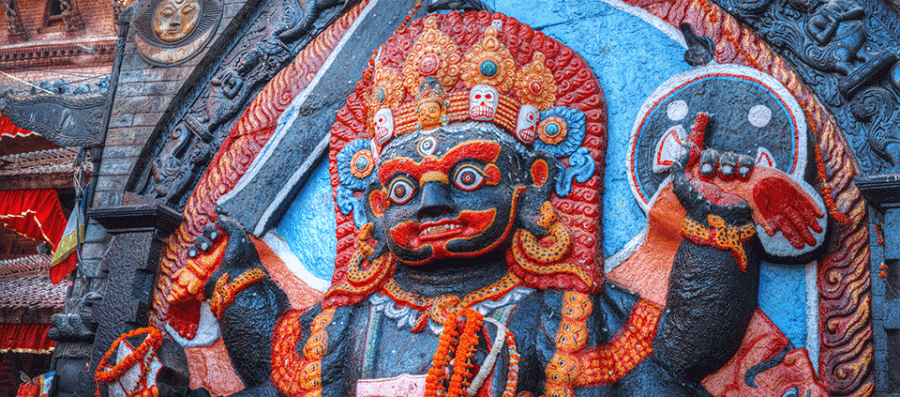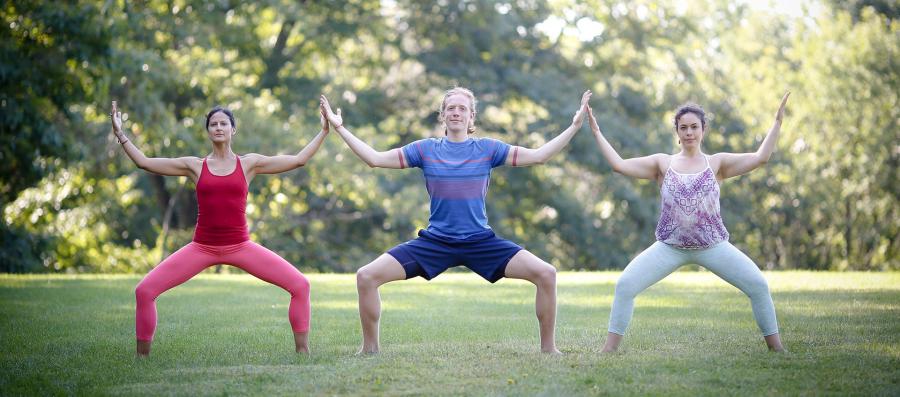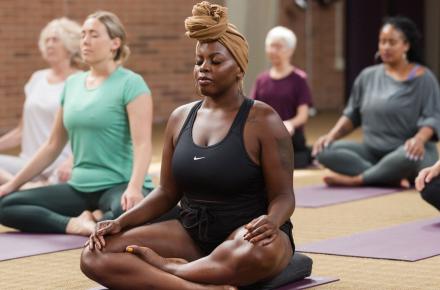Getting to Know the Goddess Kali: How to Dialogue with Your Wild Side


You don’t always have to be nice to be a yogi. The goddess Kali can help you tap into your wild side.
“You need to find your Kali side,” I told Annie. You may know someone like Annie; in fact, maybe you have an Annie in your yoga class. She’s a production manager at a local TV station, a single mom with a busy schedule, and a really nice person. She values yoga as a doorway into peace and well-being, teaches it to troubled teens, and always stresses the importance of equanimity and other yogic virtues—nonviolence, surrender, contentment, detachment.
But Annie’s approach to yoga is like her approach to life: she is so conflict averse that it’s hard for her even to admit she has negative feelings. She rarely raises her voice, and she once told me that she can’t remember the last time she felt anger. But, at this moment, mired in a family conflict that involves stolen money, elder abuse, and shady lawyers, Annie senses that her carefully cultivated tendency to seek peace over conflict is not helping her. She’s called me for advice: She wants to be told how to keep maintain her relationship with her siblings, and still stop them from cheating her mother out of her property. In other words, she wants me to give her a prescription for solving her conflict in a nice, nonviolent, yogic way.
Instead, what popped out of my mouth is, “You need to find your Kali side.” I suppose I could have put it differently. I could have told Annie about that moment in the Bhagavad Gita when the god Krishna tells the warrior Arjuna to do his duty and stand up and fight. Or I could have simply said that yoga isn’t just about being peaceful; it’s also about being strong, and wild, and forceful. Yoga, I could have reminded her, includes Warrior II, which is basically the posture you take when you’re aiming an arrow at someone’s heart.
But my intuition was that Annie needed not so much a rational argument as an image, something to bypass the cultural conditioning of her left brain–dominated mind. Annie, like so many people who practice yoga, had a half-conscious tendency to confuse “being yogic” with being nice. Not that kindness and equanimity aren’t essential yogic qualities. It was just that people close to Annie often noticed that her yogic calm looked like a way of papering over difficult emotions, knotty feelings, and desires that felt dangerous, or at least not socially acceptable.
She had yet to recognize that, even though in the West we tend to privilege the serenity-inducing, rejuvenating, and stress-reducing aspects of yoga, the yogic path is also about bringing out our strength and channeling our wildness. As you go more deeply into your yoga practice, it will ask you at some point to confront those parts of yourself that may have been suppressed by fear, trauma, or social conditioning, and which may be squelching your joy, undercutting your confidence or passion, or sabotaging your health.
***
The goddess Kali shows up in yogic art almost as much as Ganesh. Kali is the one with the wild hair, the bare breasts, and the severed heads around her neck. She usually carries a sword, and one of the ways you know its Kali is that she’s sticking out her tongue. (Try it as you read! Sticking your tongue out, all the way out, is one of the quickest ways there is to get you in touch with your unconventional wild side!) She’s usually described as the goddess of destruction, and she looks scary, even though her face and body are also beautiful. Kali is supposed to have arisen out of the warrior-goddess Durga during a particularly fierce battle with some demons. The demons had a nasty skill: Their spilled blood turned into more demon-warriors. Kali’s job was to lick the drops of blood from the slain demons, and she did it so well that Durga won the battle.
But as Kali “developed” over the centuries, this image of the wild-eyed battle goddess came to symbolize both spiritual and psychological liberation. She came to be understood as more than just a warrior: She became one of the archetypes of the Great Mother, a protector and giver of boons, as well as the destroyer of our “demonic” tendencies. There are many ways to view Kali, and the way a devotee sees her depends to some extent on his own level of consciousness.
For yogis, serious spiritual aspirants and awakened devotees, Kali represents enlightenment itself. The yogi’s Kali is the enlightening force that smashes your preconceived notions, frees you of conditioned beliefs, false personal identities, and everything else that keeps you from recognizing your true identity. In other words, part of what Kali represents is the power to release that in you that is true—not only ultimate truth, but the truth that is uniquely yours. That power often remains in shadow, hidden behind social masks, and even the masks you assume in yoga. So tuning into Kali in daily life often means tuning into aspects of yourself that you normally don’t have access to, a power that can step outside the conventional and become bold and fierce, fierce in love, fierce in ecstasy, fierce in your willingness to stand up to the “demons” in yourself and others. You don’t become free just by going with the flow. You become free by knowing when to say “No,” to fight for what is right, to be appropriately ruthless, and to engage with the fiercer forms of grace.
Kali is tough love. She’s often harsh. She has no manners. In her spiritual essence, she epitomizes the demand that you become a naked warrior for truth and freedom, ruthlessly sacrificing your own pride for the sake of liberation.
Whatever version of Kali you seek out, “finding your Kali” is always about liberation. For someone like Annie, Kali offered a kind of permission to find her warrior side. Kali’s discerning and sword-like eye cut through the disguises of Annie’s ego, woke her up, and showed her how much of her identity was actually a series of socially conditioned roles and responses and stories about herself, taken on in childhood. That meant seeing into the fear that lay behind her politeness, and then finding the part of her that could stand up both to her fear and to her siblings. At one point, I had her imagine herself as Kali—strong, fearless, holding a sword aloft, and to notice how she felt in this role.
Her response was a huge “NO!” shouted to her siblings, but also to her own passivity. She started doing an “asana” that she called Kali Pose: half a squat, raised arms, tongue stuck out, vocalizing: “Aaaaaa!” or “Nooooo!” She felt that Kali helped her hold strong as she argued with her siblings, and finally convinced them to put her mother’s money in trust, under a lawyer who was answerable to all three of them.
Annie’s siblings started, for the first time, treating her not as a little sister, but as someone who knew what to do.
Every one of us, at some point will be brought face to face with the need to discover and integrate Kali. This does not mean giving way to tantrums or violent impulses—in fact, people who have tantrums are people who are out of touch with the truth of Kali, because her energy will always bring consciousness to the unconsciously angry parts of ourselves, and allow them to transform.
However, it is also true that we are often drawn to look for Kali in those moments when our social face is breaking down, when suppressed anger or fear is threatening to overwhelm us, or when we’re faced with a crisis in which someone else’s anger seems to threaten our survival or sense of justice.
This is one of Kali’s great and secret boons. In pointing you towards those parts of yourself that you have rejected, feared or ignored, she inspires you to transform your identity, and transform it again, letting go of rigid ideas of who you and others are, stretching your emotional range, your mind, and life itself in delicious and liberating ways.
Getting to Know Kali
The simplest way to become familiar with the energy of Kali is to put an image of Kali on your alter, and look at her from time to time, imagining her qualities. Find a picture of Kali, preferably a detailed and beautiful one. Look at the image, noting her beautiful face, her wild hair, her upraised sword, the way she is dancing. Look at the necklace of skulls. Notice the emotions that come up as you look at her. Notice especially such charged emotions as fear, excitement, aversion, confusion, or attraction. “Ask” to experience Kali’s love.
Once you’ve become familiar with her visual form, you could take a few moments to meditate on her. Imagine Kali sitting before you. Take some time to feel her presence. It is not necessary to fully “see” her, but to experience her qualities: strength, love, blessing, the ability to melt obstacles, mental static, and feelings that limit your inner freedom.
Feel that an energy of blessing, filled with strength, love, and wisdom, arises from her heart in a stream of blue light, and enters your heart. Feel that Kali’s blessings purify your heart of fear and anger. If you like, you can imagine her drawing those negative emotions out of you, and dissolving them like smoke.
Feel her blessings coursing through your body, opening you to strength, enlightened clarity and love. Fold your hands in Anjali mudra, and offer thanks.
Dialoguing with Kali
Materials
To do this process, you’ll need pen and paper—enough paper so that you can continue writing as long as necessary. I also recommend having an image of Kali—a picture or computer image—that you can use invoke the Kali energy.
The Process
- Say three oms, with the intention of creating a space of sacredness.
- Spend a few moments in contemplation, recalling the symbology of Kali. Because the psyche responds to symbols and images far more readily than words, I often find that to invoke this archetypal imagery can open up realms of the personal unconscious that are otherwise unavailable.
- With a notebook and pen close by, close your eyes and summon Kali inwardly. Ask that the Kali energy in you be present. Ask, “Let me speak to Kali.”
- At this point, drop inside, and notice what is invoked in you by this question. Let yourself feel the energy of the Kali within you. If it feels natural, you might even begin to speak out loud “as” Kali. How would Kali speak? What would she say to you? Or you can go directly to the next step.
- With your dominant hand, write, “Who are you?” or “Tell me about yourself.” Then, take the pen in your other hand, and write an answer.
- Write, “What do you want to express?” With the nondominant hand, write your answer.
- Continue the dialogue as long as it has energy. You can always come back to it later.
- When the dialogue feels finished, sit quietly for a few moments, being present with the breath. Notice the spaces between the in-breath and the out-breath, the out-breath and the in-breath. Without holding your breath, see if you can be aware of how the breath arises and subsides from stillness. This open space is the essential nature of the Kali energy.
- Thank your inner Kali. Place the picture or image of Kali somewhere where you can see it.
- Take an action that feels connected to the Kali energy you’ve accessed. Kali-like activities might include a physical expression, such as wild dancing or kicking, a verbal expression, speaking a truth you have been afraid to voice, asserting a preference, doing something you never did before.
- Note any dreams, insights, or shifts that arise in the next few days.
- Once you feel that the process is more or less complete, you may burn the image of Kali, or offer it into a body of flowing water. Do this with the feeling that you are offering the energy of the goddess back into the universe, and thus taking the insights you’ve received deeply into your own being.
Reprinted from Yoga Journal by permission of the author.


















































